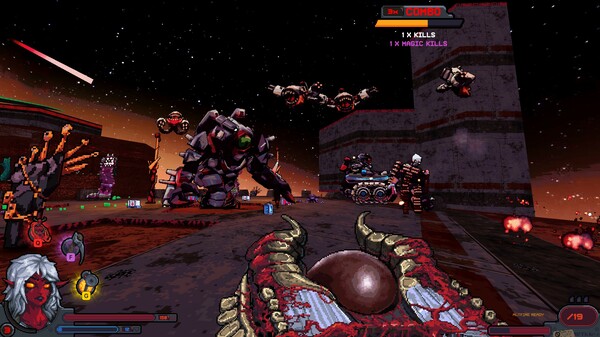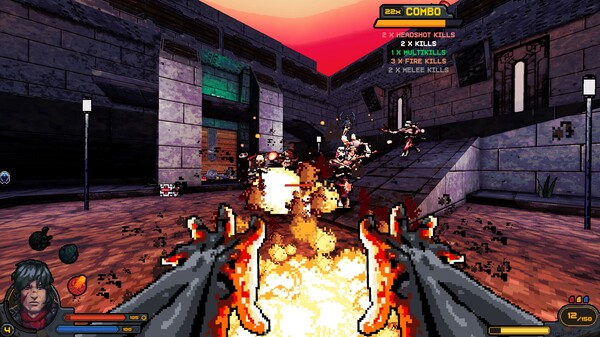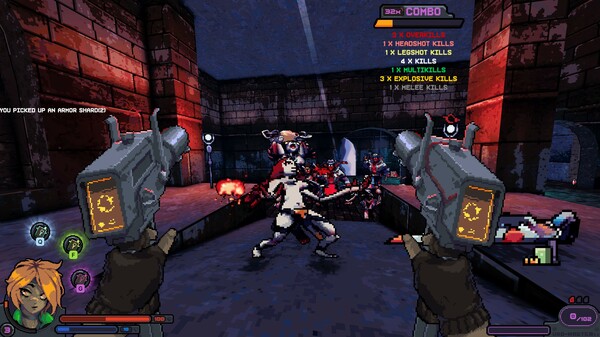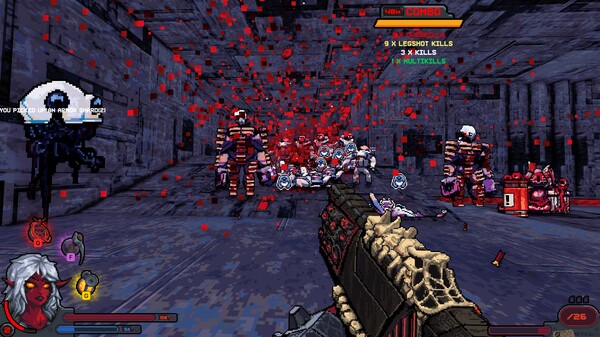That was something. I had a blast enjoying the entirety of the Project Warlock 2 experience, but it was kind of... a mess. A huge and wonderful mess. Project Warlock 1 was a tightly packed, cohesive, and solid game. A renewed, but restrained take on the anemic and labyrinthine structure that was the core design of Wolfenstein 3D . Besides the striking art direction that captured the same feel of classic sprite-based games—but brought in crispy animations with more frames than usual—and a handful of interesting additions like an RPG progression system with attributes, skills, and a fresh weapon upgrade system, it gave the air of a nostalgic game that modernized the original experience and created something new enough to stand out among its peers. More like a good bite-sized dungeon crawler with shooting and melee mechanics. It was a short, very polished and replayable game with a good variety of content. A great buy for anyone interested in the genre. Project Warlock 2 attempts to expand the principles presented in the first game in almost every way. More weapons, bigger levels, verticality, more enemy types, more builds, more effects, more narrative. In short, more of the same—but bigger and better. Louder. And frankly, I think they pulled it off—but at the cost of any cohesion and sense of balance. It’s like the developers, through many iterations, came to the conclusion that if the game doubled down enough on what it does best to the point where the player wouldn't care about the rest, they’d be successful. And, well… they were. PW2 is pure chaos. It’s so excessive that it tramples over any negative feelings that could arise from such a disjointed experience. Shooting in this game is glorious. Every single weapon is incredibly satisfying to fire. Crunchy and impactful sound design. Powerful. Enemies explode in a festival of particles. Resources flood the screen every second. Entire hordes feel like they’re charging at a massive atomic meat grinder on legs that shoots missiles. Upgrades and spells just make the party even more unhinged. How about dual-wielding SIX-BARREL shotguns that you can fire all at once without needing to reload? Ammo evaporates in seconds, but enemies owe you HP for thirteen generations. Or how about a heavy machine gun that upgrades to fire even faster(Full auto or fuller auto)? And what if it also shoots flaming or poisonous bullets? Or a hand cannon with infinite ammo as long as you keep landing headshots? Or a nuke with a blast radius so wide you’ll probably die every time you use it? How about a death laser? It’s insane. And the game pairs that extreme firepower with unbelievable fights against so many enemies at once that sometimes you can’t even tell what’s on screen given the level of visual noise. You can’t even hear the damn music! Sometimes it makes you feel like you just parachuted into the angriest Wall of Death in the world. None of it makes any sense. There’s barely any structure or planning. It’s just a mess. And it’s amazing. There doesn’t seem to be any encounter design in this game. You just walk and get constantly ambushed in generic spaces and forced to destroy everything in sight. Any attempt at giving enemies a meaningful role in a dynamic, elegant, and well-structured combat dance disintegrates the moment the game turns up the heat (which is basically all the time). You’re swimming in resources and never need to worry about anything. And the combo system rewards you more and more the higher your count gets. The combat has all the red flags to be immensely frustrating, but the game buffs you so much and gives you so many tools that you just win by attrition. There is no challenge that can withstand so much firepower. The progression system is broken and wrecks any sense of balance the game might have had, and at same time it feels thin and insignificant, with little perk variety and prerequisites that practically force you to invest in attributes that have no synergy with the rest of your “build". “Build”, because, aside from the weapons, it’s hard to feel any significant difference in your choices. It feels like they all lead to the same place, and that kind of defeats the purpose—especially when every chapter resets all your powers in the name of variety that, I imagine, could’ve been achieved in other ways that are now, sadly, unreachable for an already launched project. The game also does a poor job of returning you to where you left off between chapters, making each feel like a separate campaign rather than a continuous experience. I have no idea why I always need to reach mission 7 just to regain access to features I’d already been introduced to in the previous chapter. It’s like they forgot this was supposed to be a continuation of established concepts, not a reset from the beginning. It gets worse because you don’t even get to experiment. Every upgrade is permanent, even if you allocate a point by mistake. The incentive to explore builds is neutered right from the start, and it doesn’t make much sense since you’re always progressing toward another reset—without the previous weapons. I’m not replaying an entire chapter just to see what I missed. Level design also fails to support or enhance the rest of the experience, falling short of providing a consistent quality. And unfortunately, very few levels are noteworthy conceptually. In the first act, levels are large and more open, but they fail both at selling a sense of place and at being compelling video game levels, because the environments feel too artificial and are not very interesting to navigate. Without clear structure, progression, or direction, they make you feel like you’re going nowhere, not advancing through the space or decoding the layout. I never actually got lost, but I never felt like I was exploring or making meaningful progress either. Levels just started and ended, and I moved on to the next without registering what I’d seen. The lack of meaningful enemy and resource placement, and of distinct segments, stripped a lot from these levels—making them feel homogeneous and interchangeable. The pacing is all over the place. The so-called “sprawling verticality” promised in the store description is practically nonexistent. Instead, you get several uninspired areas filled with geometry that serves no gameplay purpose. In the second and third episodes, things simplify quite a bit, becoming smaller and more to the point, focusing more on a continuous combat experience—which is a bit better, but most of it is still feels pretty generic. Just more concise. Oddly enough, in the second, the combat slows down, becoming more restrained and ironically making the difficulty curve feel inverted. Then in the third, things go off the rails in the opposite direction—levels become even shorter and simpler, and combat becomes fifty times more relentless than in the first act. And then it ends. Leaving a very mixed impression. Strangely satisfying. Combined with everything I described above, it feels like—unlike its predecessor—the game lacks any clear direction in what it wants to be and how to expand upon already established premises. There are a LOT that just don't fit together properly. To me, the developers tried to make a drastically different type of game while still trying to force it into the same mold of the original. And the result was this: An incoherent mess, insane enough to be entertaining. It barely holds together. You might not even understand what you’re seeing or doing, but in the end, it’s great.
Expand the review






















